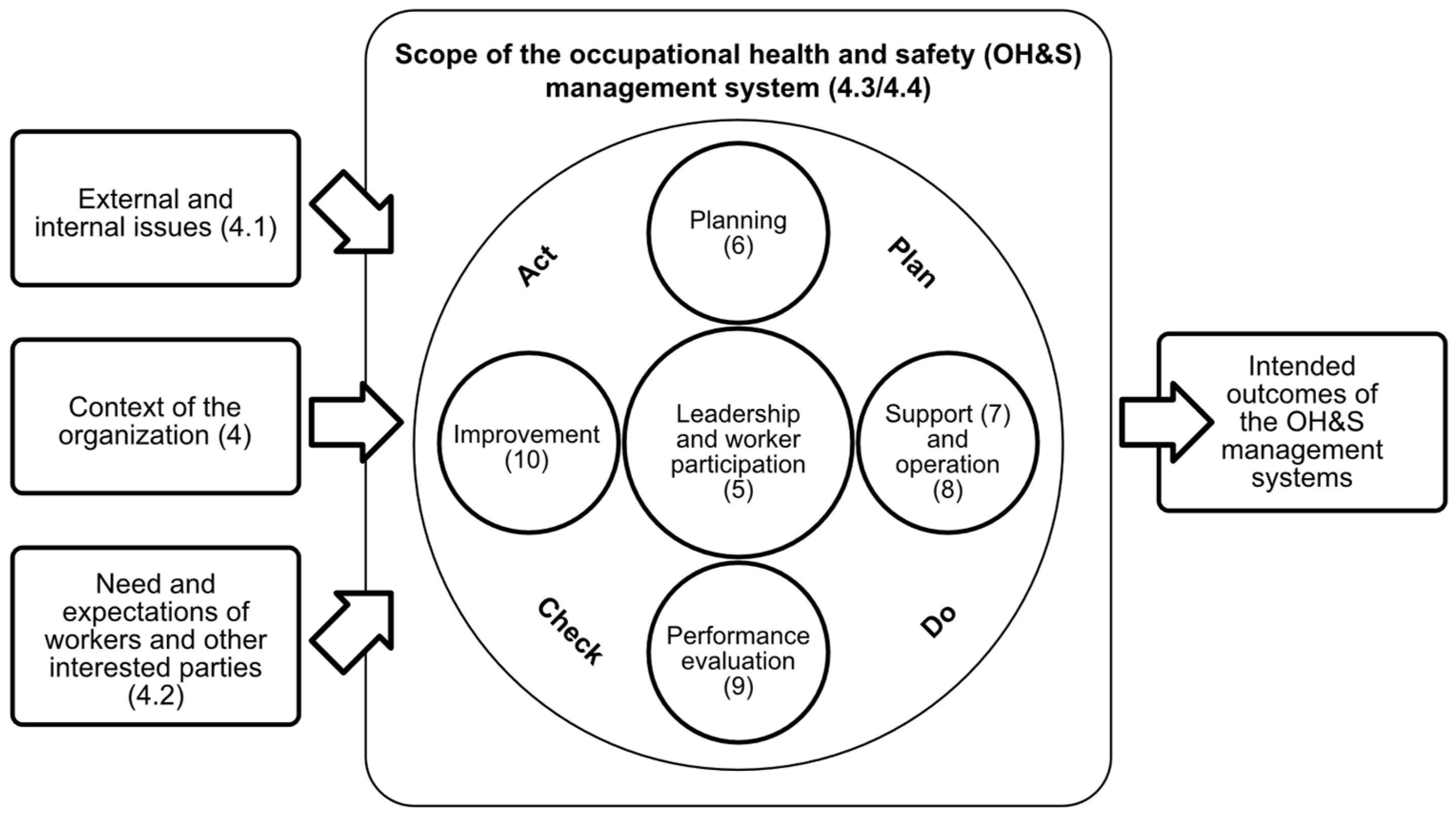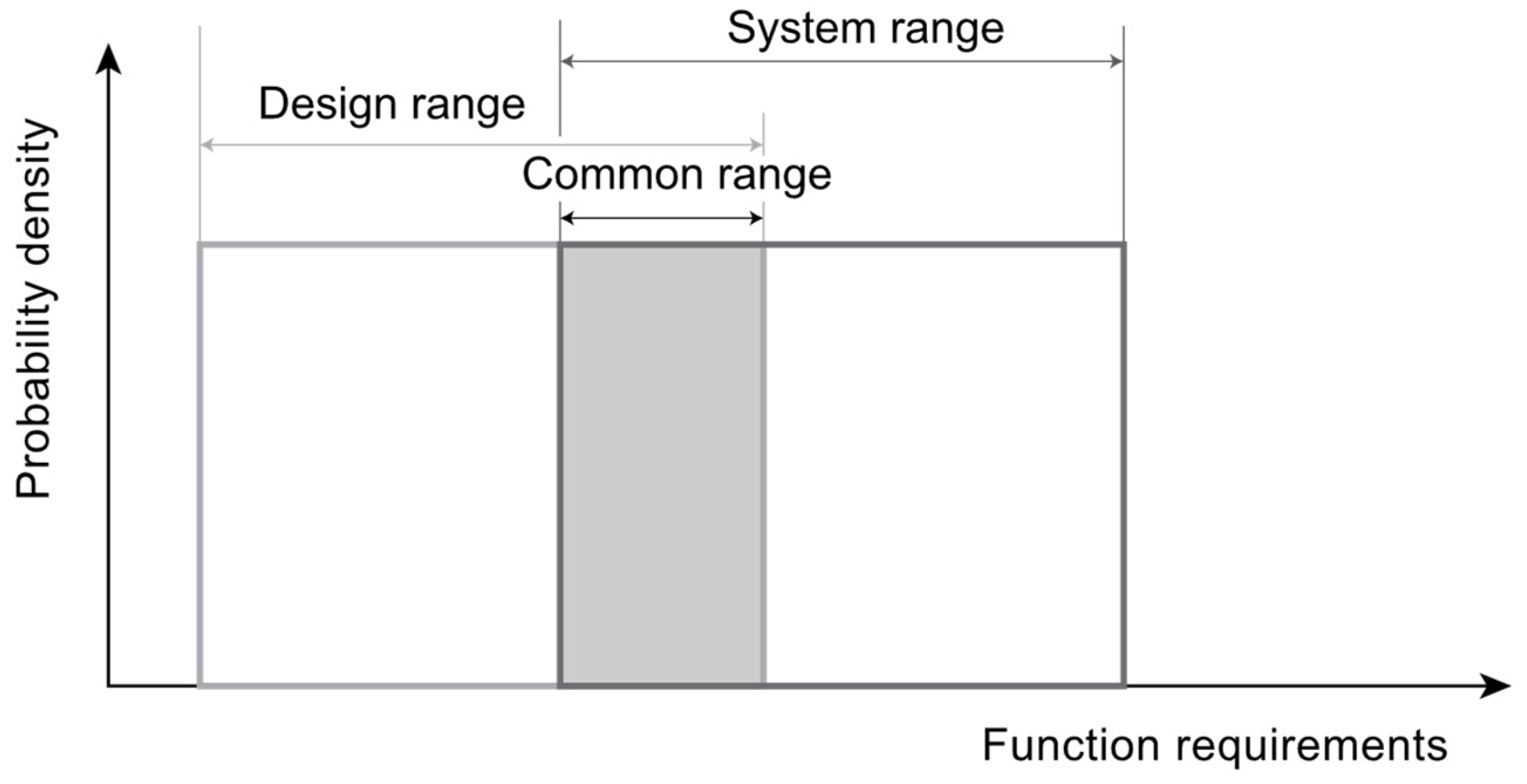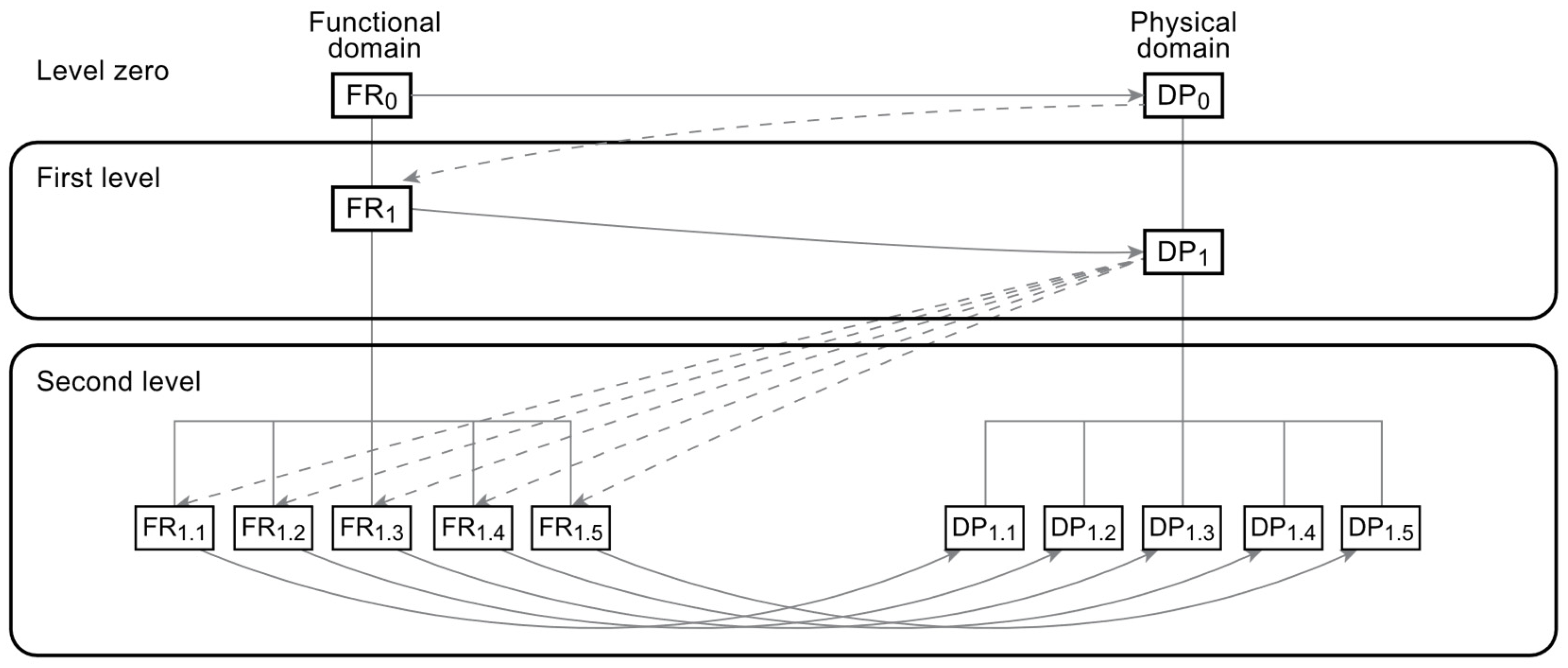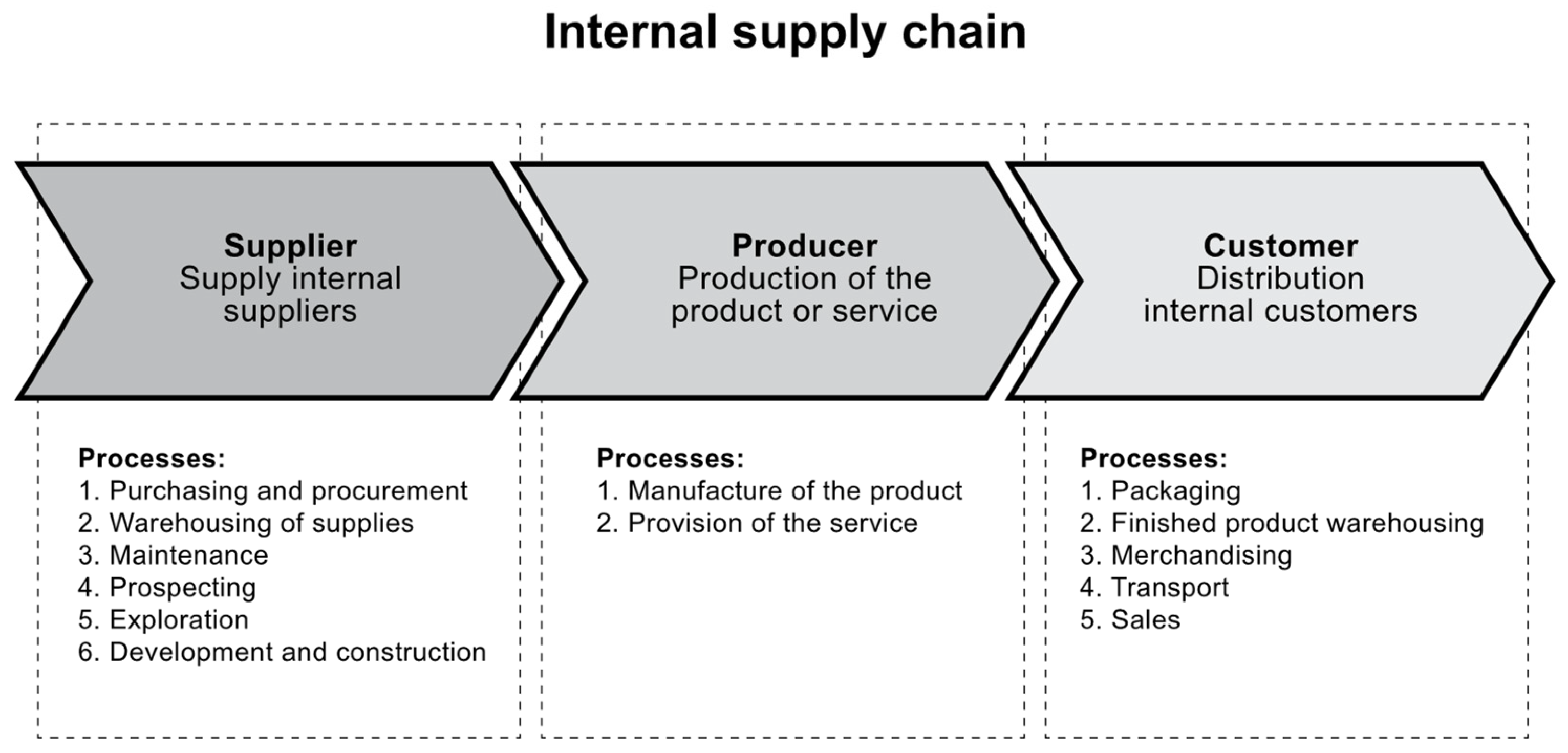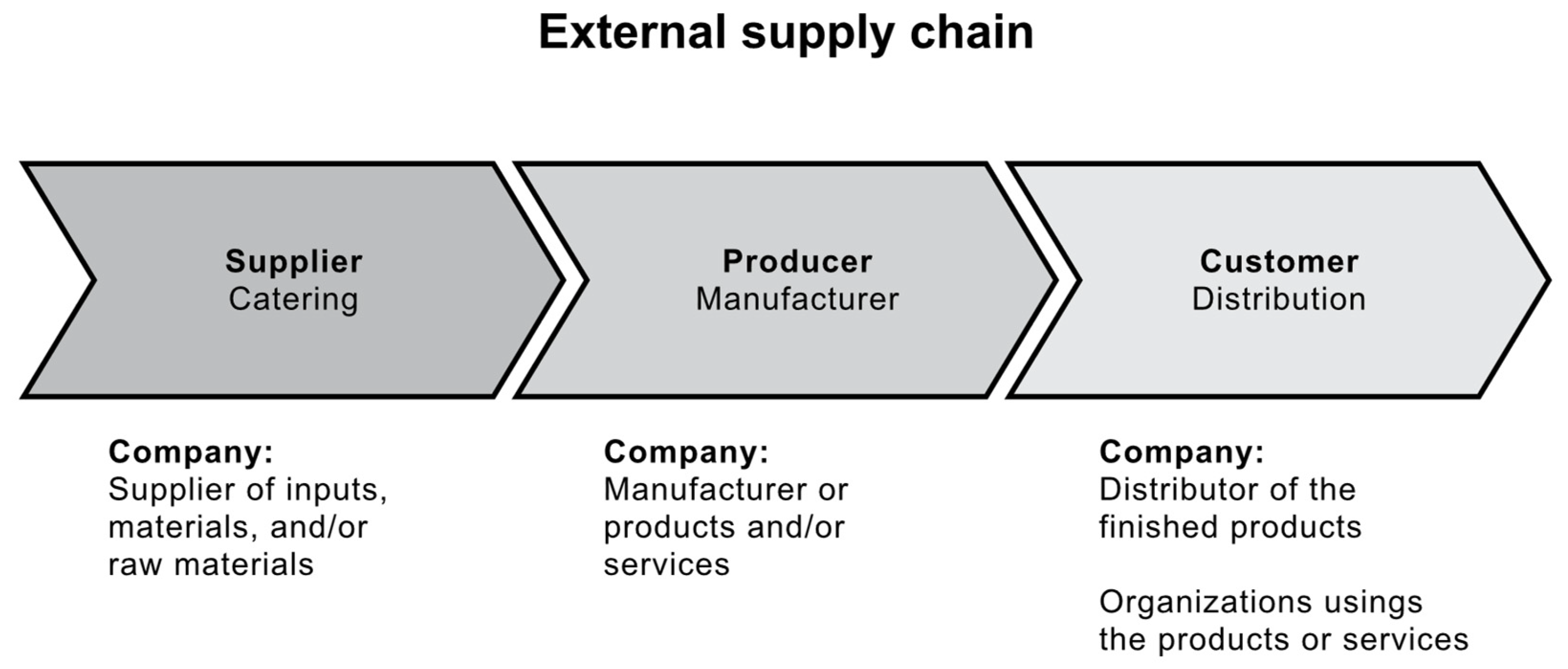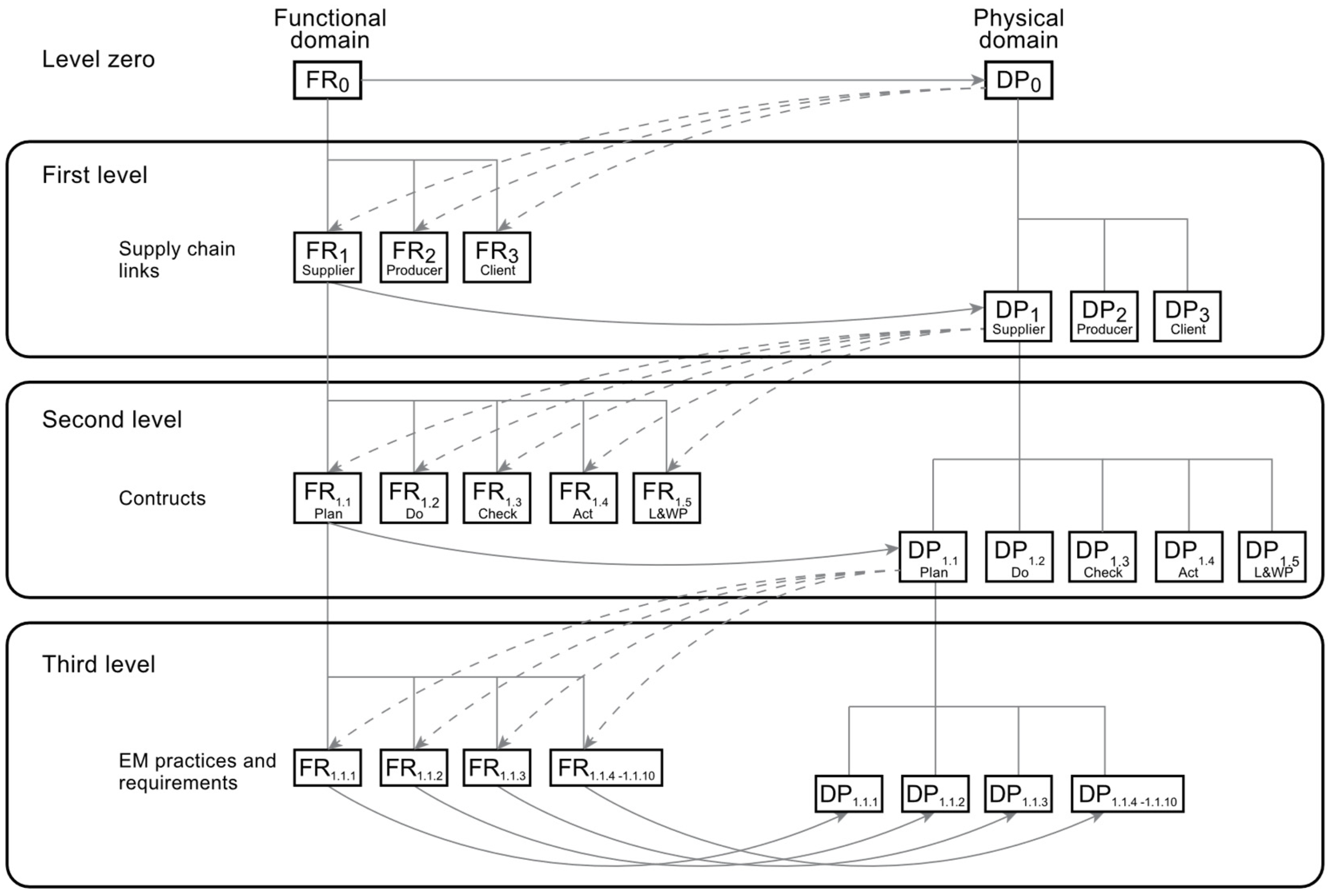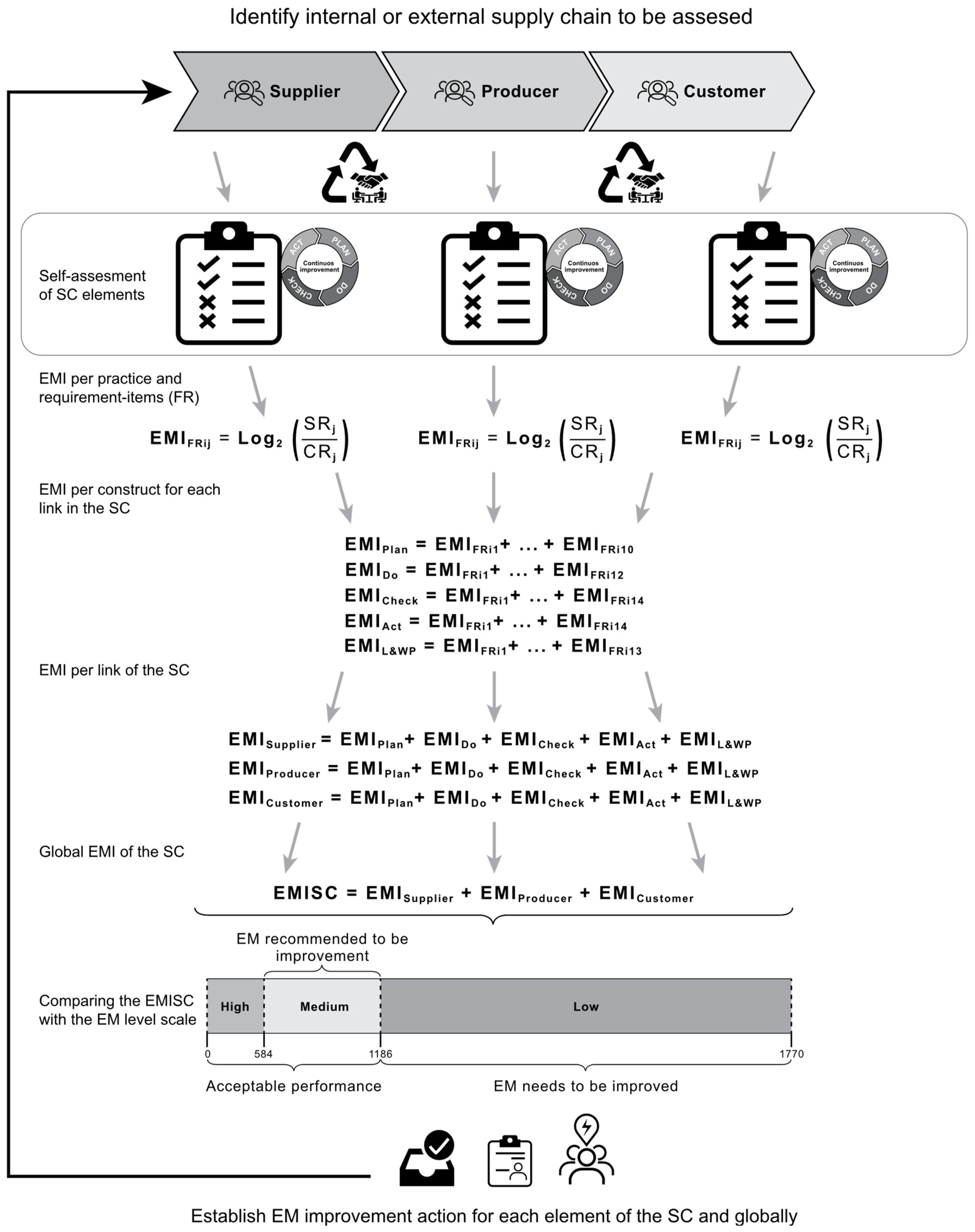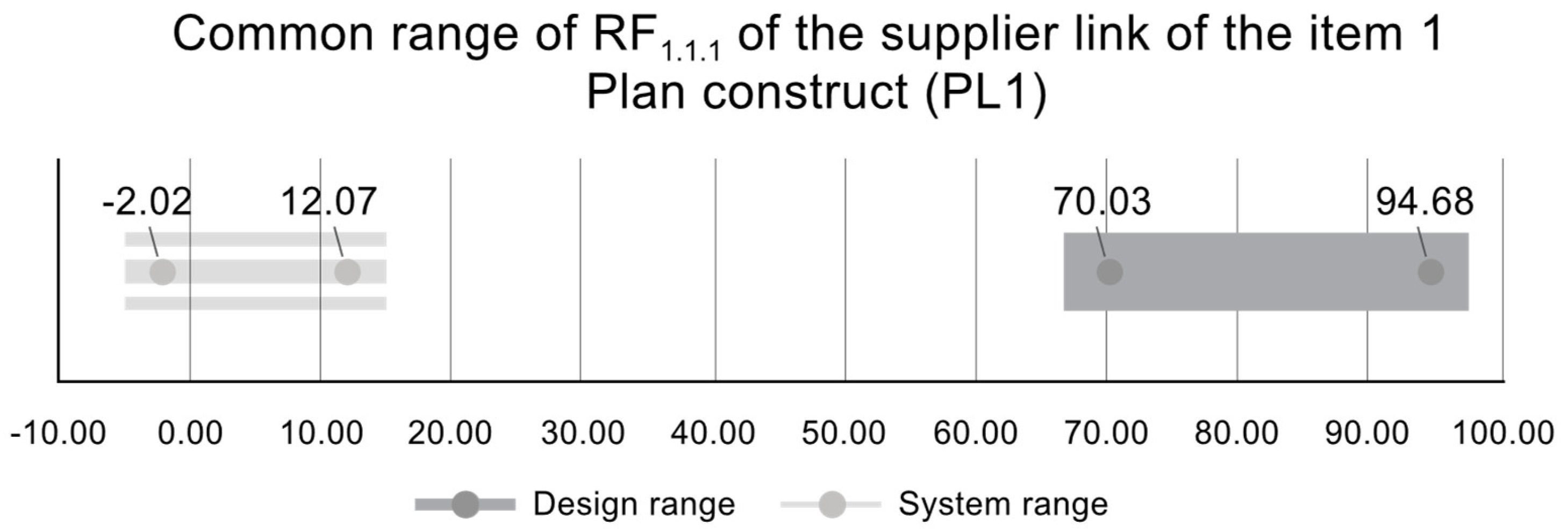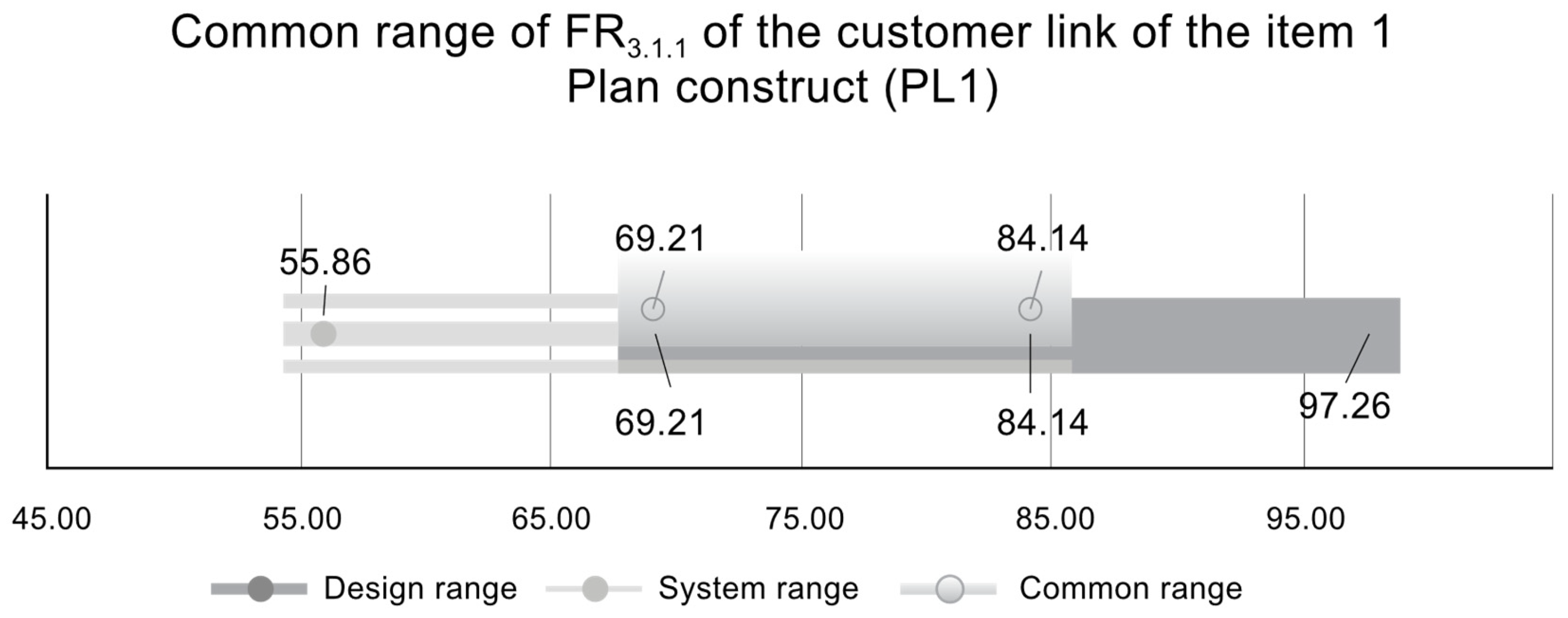1. Introduction
There is a growing focus on sustainable management of supply chains (SCs) [
1], and sustainable practices have been adopted on a large scale [
2,
3]. According to Coyle et al. [
4], SCs are integrated by companies that must share information and coordinate physical execution for an integrated and fluid flow of goods, services, information, and cash. Therefore, the focus on sustainability in SCs seeks a balance of three pillars: economic growth, social welfare, and environmental protection, promoting responsible and efficient use of resources. This balance can be achieved by implementing strategies addressing these three fundamental sustainability aspects. Social sustainability (SS) is where the present research contributes since it seeks to provide an evaluation model of ergonomics management (EM) to achieve a safe and healthy environment for all employees of the SC, where the EM favors the creation of increasingly efficient processes and work environments which are adequate, and/or adapted to human capacities and limitations. Therefore, ergonomics can contribute to SS in organizations since both concur in the search to improve the quality of life of people at work by contributing socially to a highly competitive global market.
SS in organizations is a construct that demands preventive occupational health and safety, human-centered work design, empowerment, individual and collective learning, employee participation, and work-life balance [
5,
6].
On the other hand, EM is defined as a set of procedures and actions aimed at identifying ergonomic risk factors, planning and implementing an ergonomics program, establishing the control of risks and hazards through good practices, and setting goals to reduce or eliminate them in man-machine systems and work environments [
7]. Ergonomics can be a means for SS in SC. From the SC perspective, SS has been adopted under corporate strategies such as the socially responsible company brand name [
8,
9].
Also, the human factors and ergonomics field (HF/E) has debated whether and how ergonomics or human factors can play a role and contribute to the SS of SC, given that both disciplines are concerned with improving human welfare, equity, and life quality at work and the everyday environment. Furthermore, considering that human characteristics, behavior, performance, and human interactions with technology are vital elements of SC, there seems to be a natural synergy between both disciplines, aiming to understand and optimize the outcomes of human-system interactions to develop sustainable use of human resources, so ergonomics and these aspects of sustainable development can be expected to be good partners [
10]. Thus, there is evidence in the literature of its contribution to SC, where ergonomics is becoming increasingly important, as it is considered a crucial parameter for achieving sustainability [
11].
Nonetheless, part of the problem of this research is that members of an SC are entitled to implement ergonomics and face several obstacles [
12], such as:
The SC faces frequent changes in suppliers and companies.
The frequent changes in the products and systems of the chain also lead to organizational changes.
Subsidiaries of multinational corporations are also subject to changes in management, organization, and production philosophies.
In addition, the literature recognizes two further difficulties. The first is associated with the lack of a social approach to SC. In contrast, the second relates to the lack of reliable and effective indicators and metrics for evaluating SC ergonomic management.
In this regard, for Korkulu and Bóna [
13], the social approach has received insufficient attention in both SC management and sustainability issues addressed by researchers. Therefore, companies and academics have cooperated to consider SC as a whole and toward sustainability [
14,
15]. Also, there are attempts in the literature to establish a primarily accepted theoretical-practical framework for assessing SS in SC. However, this goal has not yet been fully achieved, and there is a high degree of misalignment of information and concepts [
16]. Additionally, Seuring [
11] stated that social issues are poorly addressed in the design of sustainable supply chain (SSC) practices, considering that research on sustainable supply chain management (SSCM) practices is scarce [
17]. These findings are evidence of the problem’s relevance in understanding the impact of HF/E on society and the quality of life of human resources, as well as the economic benefits for companies that have successfully implemented ergonomics and achieved their SS objectives.
On the other hand, regarding the second difficulty, the lack of reliable and effective ergonomics indicators and metrics in evaluating SCs helps define the relevance of this research. As an example, Cantor [
18] and Perttula [
19] have pointed out the need for comprehensive Ergonomics studies in SCs for an evaluation approach of all the links using a holistic view and considering that the definition of criteria for SS is not yet firmly established [
12]. Additionally, due to the complexity of this problem, a broader view of health and quality of life in SCs is needed [
20].
In addition, there are a variety of metrics related to ergonomics in SC. Organizations use these metrics to evaluate performance; however, their purpose should go beyond their measurement and be a guide to establish actions or strategies for improvement. These metrics can make organizations globally competitive by complying with Ergonomics requirements. Some of the organizations that led the evaluation of these requirements are OHSAS (Occupational Health and Safety Assessment Series) 18001 of 2007, ISO (International Organization for Standardization) 45000, and ILO-OSH (Occupational Safety and Health Management Systems) 2001.
Until now, SCs have not been the object of study or evaluation from an ergonomics perspective. Transferring metrics measurement to the SC partners would also be relevant. So far, supplier assessments have been carried out, further broadening the scope of SC, but there is a lack of an overall SC assessment index within an ergonomics approach.
Due to their specificity, the actual indices are limited for SC evaluation because they are associated with specific variables, such as the number of accidents, risk factors, and compliance with current regulations, which are relevant but are unable to assess the ergonomics management among the SC companies’ members and the SC itself. Consequently, the evaluation scope is restricted to a single link within the supply chain, and a comprehensive measurement approach for the entire supply chain has not yet been proposed.
This gap presents a research opportunity to thoroughly evaluate supply chains and their member companies as they work toward socially sustainable objectives through ergonomics management. The existing literature acknowledges the absence of an ergonomics management evaluation model (EMEM) for supply chains that could aid in achieving sustainability goals and facilitate a detailed evaluation of their interconnected links.
Therefore, this research aims to propose an EMEM designed for supply chains, offering a holistic evaluation approach along with an ergonomics management index for a single SC link and the entire SC. A global measurement approach throughout the SC has not been proposed yet.
Accordingly, this research aims to propose an EMEM that applies to SCs by proposing a complete evaluation approach and an ergonomics management index. This objective formulates the following research question and hypothesis.
Are the EMEM and indices valid for assessing the supply chain through the axiomatic design methodology?
H1. The proposed EMEM and EMIs are statistically valid and can be used to assess the supply chain through the axiomatic design approach.
The structure of the paper is as follows.
Section 1 presents the background of the research and the problem statement.
Section 2 provides the theoretical background on the relevant concepts and main theories used to develop the EMEM for SC.
Section 3 details the materials, methods, and procedures for constructing and implementing the EMEM for SC.
Section 4 presents the results of the EMEM development through the axiomatic design, through a case study of the application of the EMEM and practical recommendations.
Section 5 discusses the features of the current ergonomics management evaluation models that can be contrasted with the proposed model to highlight the main differences and advantages. Finally,
Section 6 summarizes the research findings and outlines directions for future research.
3. Materials and Methods
The continuous improvement instrument for ergonomics management system evaluation (CIEMSE), proposed by Rodríguez-Gámez et al. [
47], was used in the EMEM in two evaluation schemes. First, design ranges (DRs) were defined by 34 experts from Latin America. Then, system ranges (SRs) were assessed by self-assessments of EM practices to obtain the information content axiom in one Mexican salt industry case study. In addition, the Leadership and worker participation construct was considered in both instruments.
Table 1 shows the domains considered in the two assessment schemes.
Figure 4 shows the development of the EMEM of the SC:
3.1. Step 1. Development of the EMEM of the SC Using an Axiomatic Design Approach
The axiomatic design (AD) methodology proposed by PhD. Nam P. Suh [
54], was used to develop the EMEM of the SC. First, the four design domains—the CAs, FRs, PDs, and PVs—and their interrelation through mapping are determined. Subsequently, the EMI is obtained using the information axiom. The following sections explain the development procedure.
3.1.1. Determination of Customer Attributes (CAs)
In the customer domain, the attributes or needs of the users (customers) of the EMEM for SC were determined. These attributes were identified considering the need for an evaluation model that contributes to the fulfillment of the SS through the analysis of the systematic literature review conducted by Rodríguez-Gámez et al. [
7].
3.1.2. Define FRs of the System
The functional requirements (FRs) of the EMEM for the SC were determined by satisfying the CAs or client needs established in the previous stage. The practices and requirements of the ISO 45001:2018 Occupational Health and Safety Management Systems standard were used to manage hazards in the workplace and systematically identify, control, and verify the reduction of risk factors. The practices and requirements were adapted to the EM considerations through a detailed analysis and relevance process. Input and system constraints were also determined. The former were imposed as part of the design specifications of the evaluation model, and the system constraints were imposed by the system in which the evaluation model was to operate.
3.1.3. Mapping Between the Domains and Decomposition of {FRs}, {DPs}, and {PVs}: A Step in the Creating System
The next step is to translate the FRs from the functional domain to the physical domain, that is, to conceive a design and identify the design parameters (DPs). The mapping was done between what we want to achieve (FR) and how we want to achieve it (DP).
Maldonado-Macías et al. [
49] suggested some considerations used to establish the DPs of the EMEM for SC:
Generate a list of what the design should do.
The wording of the DPs should start with a noun.
The PDs must satisfy the established FRs.
Select for each FR a DP.
Have physical tolerances.
To determine the process variables (PVs), we considered controlling the DPs set at each hierarchical level and ensuring compliance with the FRs set through the necessary processes or procedures. The decomposition of FRs, DPs, and PVs involved zigzagging between domains until the design of the EMEM for SC was completed.
Figure 5 shows this process: The FRs are decomposed into a hierarchical structure, and the DPs are defined to satisfy the FRs at each hierarchy level.
3.1.4. The Independence Axiom
The design matrix [A] was developed to identify whether it is coupled or not to comply with the independence axiom, as it is preferable that each of the FRs must be satisfied independently by a DP in an uncoupled design matrix.
3.1.5. Ergonomics Management Index from Information Content Axiom
The information content axiom indicates the complexity and probability of the design’s success by satisfying the FRs set out in the design. For the design of the EMEM for SC, the ergonomics management index (EMI) was used to indicate the level of compliance with ergonomics management practices and requirements (EMPr&Rq). In this, the probability of compliance using the two evaluation schemes and the relationship between the results of the two schemes must be determined.
The first Scheme determines the design range (DR), where the minimum desirable percentage of compliance of the EMPr&Rq established by the experts is considered; the other Scheme determines the system range (SR) through the responses of the rate of compliance of EMPr&Rq by the organizations participating in the SC. The common range (CR) is established due to the ratio of the two design and system range distributions. The SR and CR are used to determine the EMI. The EMI equation shows the following:
The lower value of EMI represents less uncertainty in satisfying the FRs; therefore, the assessed system may be more likely to meet the experts’ expectations for each EMPr&Rq. The procedures for determining DR, SR, and CR are described below.
3.2. Step 2. Procedure for the Design Range (DR): First Evaluation Scheme
The DR makes it possible to establish the tolerances or limits of acceptance or compliance of implementing the EMPr&Rq in the SC. For this purpose, the following procedure is shown:
The experts must answer the ergonomics management expert instrument (EMEI) and establish the minimum desirable percentage (xmdp) value for each FR (item).
These values are used to calculate the average of the minimum desirable percentage value of compliance with the EMPR&Rq.
= Is the average of the minimum desirable percentage values of the compliance of the EMPr&Rq.
= Is the minimum desirable percentage value for each FR given by the experts
n = Number of experts who established the xmdp values for each FR.
- 3.
Determine the DR for each FR by calculating the standard deviation, the upper and lower limits. The equations for this purpose are shown below:
= It is the standard deviation of the minimum desired percentage values given by the expert sample for each FR.
XDRupper = It is the upper limit of the DR for each FR.
XDRlow = It is the low limit of the DR for each FR.
DR = It is the design range for each FR.
The DR established for each FR by the experts is used to evaluate the performance of the different links that make up the SC since each link is an organizational system where employees participate and require better working conditions, as well as the implementation of good practices and ergonomics requirements.
3.3. Step 3. Procedure for the System Self-Assessment—System Range (SR): Second Evaluation Scheme
The SR allows the establishment of the real capacity of the evaluated system to satisfy the FRs of the EMPr&Rq implementation in each SC link. For this purpose, the following procedure is shown:
The respondents (employees of the system to be evaluated) must answer the ergonomics management self-assessment instrument (EMSI) and establish the value compliance percentage (xcp) with the EMPr&Rq for each established FR under the evaluation of the link in which the respondents participate. It should be noted that the participants’ responses should not be mixed if they belong to different SC links.
These values are used to calculate the average of the minimum desirable percentage of compliance value with the EMPR&Rq.
= is the average of the compliance percentages values with the EMPr&Rq for each FR and per assessed link given by the participants of the self-assessment.
= is the compliance percentage with the EMPr&Rq for each FR, as given by the participants and per the evaluated link of the SC.
n = number of participants who self-assessed the level of compliance of each FR and per link of the SC assessed.
- 3.
To obtain the SR for each FR in each link of the SC by calculating the standard deviation, along with the upper and lower limits. The equations for this purpose are shown below:
= It is the standard deviation of the compliance percentage values for each FR and per link of the SC given by the self-assessment sample.
XSRupper = It is the upper limit of the SR for each FR and per link of the SC.
XSRlow = It is the low limit of the SR for each FR and per link of the SC.
SR = It is the system range for each FR and per link of the SC.
3.4. Step 4. Procedure for the Common Range (CR)
The DR and SR for each FR must be calculated to determine the CR. The procedure is shown below:
Plot the DR and SR through each FR’s upper and lower limits.
Figure 6 shows an example of design range, system range, and common range in a probability density function plot.
Identify the area of intersection (overlap) between the DR and SR. This involves comparing the limits of allowable variation (minimum desirable percentage of compliance for the EMPr&Rq), represented by the DR with the actual variation provided by the assessed system (percentage of compliance with the EMPr&Rq), represented by the SR.
Determine the CR utilizing the seven cases as appropriate.
Case 1: Overlap exists when the upper limit of the DR is greater than or equal to the lower limit of the system range (
XDRupper >
XSRlow). In addition, the following two conditions must be verified: the upper limit of the SR is greater than the upper limit of the DR, and the lower limit of the DR is greater than the lower limit of the SR (
XSRupper >
XDRupper and
XDRlow <
XSRlow), as shown in
Figure 6 below, which means that the design expectations were covered and exceeded by the results of the system evaluation. Consequently, the minimum information content is achieved, and the SR can become the DR for consequent evaluation of the corre-sponding FR.
Figure 6.
Case 1 to determine the common range.
Figure 6.
Case 1 to determine the common range.
Therefore, the CR is determined by the following equation:
Therefore, for this evaluation model purpose, the EMI = 0 for the evaluated FR.
Case 2: There is overlap between DR and SR when the upper limit of the XSRupper is greater than XDRlow (XSRupper > XDRlow). Additionally, for this case to apply, the following two conditions must be verified: the upper limit of the DR is greater than the upper limit of the SR, and the lower limit of the DR is greater than the lower limit of the SR (XSRupper > XDRlow and XDRupper > XSRupper), which means that the evaluated system partially met the design expectations. Therefore, the CR is determined by the following equation:
Case 3: Overlap does not exist between DR and SR, since the upper limit of the XDRupper is lower than the XSRlow (XDRupper < XSRlow). However, for this model purpose, this means that the result of the evaluated system exceeded the design expectations. Therefore, the CR is determined by the following equation:
Since the design expectations and the system evaluation results do not overlap, the minimum information content can be achieved and the EMI = 0 for the evaluated FR.
Case 4: Overlap does not exist since the lower limit of the XDRlow is higher than the XSRupper (XDRlow > XSRupper), the design expectations are not met with the results of the evaluated system. Therefore, the CR is determined by the following equation:
Since the design expectations and the evaluated system’s results do not overlap, for this evaluation model purpose the EMI is equal to 10 for the evaluated FR.
Case 5: Perfect overlap occurs between DR and SR when XDRupper = XSRupper and XDRlow = XSRlow, which means that the design expectations are met with the results of the thoroughly evaluated system. Therefore, the CR is determined with the following Equation:
Since the design expectations and the evaluated system’s results are entirely overlapped, the EMI is equal to 0 for the evaluated FR.
Case 6: There is an overlap between DR and SR when the upper limit of the SR is greater than the upper limit of the DR, and the lower limit of the DR is greater than the lower limit of the SR (XSRupper > XDRupper and XDRlow > XSRlow), which means that the design expectations were partially covered by the results of the system evaluation; however, there are ergonomics practices improvement opportunities in the results of the evaluated system since they do not cover the expectations (minimum requirements) of the design. Therefore, the CR is determined by the following equation:
Case 7: There is an overlap between DR and SR when the upper limit of the DR is higher than the SR upper, and the lower limit of the SR is higher than the lower limit of the DR (XDRupper > XSRupper and XSRlow > XDRlow), which means that the results of the system evaluation fully cover the minimum design expectations. Therefore, the CR is determined by the following equation:
3.5. Step 5. Ergonomics Management Index (EMI) for EMEM of the SC
This step establishes the basis for the determination of the EMI for each element of the EMEM of the SC, which can be obtained at different levels depicted in
Figure 7.
One of the main advantages of the model derives from the additive nature of the information axiom, which offers versatility in assessment and facilitates obtaining the EMI at all levels of the SC. FRs, constructs (Plan, Do, Check, Act, and Leadership and Workers Participation) for the supplier, producer, and customer. Therefore, the model calculates the EMI for each EMPr&Rq using Equation (9) to be determined until the overall EMI of the SC (EMISC) is obtained from the process of adding each independent result and respecting the hierarchy (in
Section 3.1.5, the equations for the calculation of the EMIs are shown). At the base of
Figure 7 are the items or FRs assessed in the EMSI, at the second level are the constructs or domains for each link, while the third level shows the links that make up the SC. Once the EMISC is obtained, it is compared with the EM scale (see
Figure 8) to determine the level of management of the SC assessed and the need for intervention through an action plan. The complete procedure for applying this model will be presented in
Section 3.6. In addition, a case study will be deployed in
Section 4.2.
3.6. Step 6. EMEM of the SC Procedure
Implementing the EMEM of the SC requires a procedure consisting of 5 phases. These phases are shown and described below in
Figure 9:
3.6.1. Phase I: Supply Chain Identification
In this phase, the SC under study is identified to establish the actors involved in it, who will be the evaluators of the compliance of the EMPr&Rq. The evaluation can be implemented considering (1) a product, (2) a particular service, or (3) a company in general. The SC to be assessed can be internal or external. For the internal supply chain (ISC), the functions or processes performed by the different departments of the assessed organization are identified. For the external supply chain (ESC), the organizations participating in the chain are identified. To facilitate the identification, two diagrams are provided: (1) ISC (see
Figure 10) and (2) ESC (see
Figure 11).
Once the type of supply chain has been identified, a minimum of 2 participants per link are identified. The participants must hold middle and/or senior management positions, have knowledge of ergonomics, and know the functions and processes of the links under study.
3.6.2. Phase II: Evaluation Schemes—Design Range and System Range
The two evaluation schemes will determine the DR and SR in this phase. The first one, the DR, will be obtained by considering the answers of experts who determine the minimum desirable percentages of compliance for the EMPr&Rq for each FR established in the evaluation through the EMEI. The DR should be determined for each FR using the design range procedure described in
Section 3.2. The second scheme system rank will be obtained by considering the answers of the chosen personnel of each department or organization to be assessed that participate in each element (Supplier, Producer, and/or Customer) of the SC; they will have to answer the EMSI establishing the percentage of compliance for each practice and requirement (items) of the EM. The SR must be established for each FR (item) using the system ranking procedure described in
Section 3.3.
3.6.3. Phase III: Determination of the EMI per Element
In this phase, the common range between DRs and SRs for each FR (practice and MS requirement) is determined using the common range procedure described in
Section 3.4. In addition, the EMI per practice and requirement (item), per construct, and link, as appropriate, is determined as specified in
Section 3.5.
3.6.4. Phase IV: Obtaining the EMISC and Performance Level
In this phase, the EMISC is calculated according to the
Section 3.5, and the result obtained is compared with the EM scale (see
Figure 8) to determine the management level of the assessed SC.
3.6.5. Phase V: Feedback and Action Plan
The results obtained for each EMI should be analyzed to feed back into each EMPr&Rq, construct, and SC link. Priority EMIs have the highest values or scores. In addition, if necessary, an action plan should be established to improve the performance of the EMPr&Rq in the evaluated SC through improvement actions.
5. Discussion
As a discussion, the current ergonomics management evaluation models present some characteristics that can be contrasted to the proposed model to highlight the main differences and advantages.
Neves et al. [
55] propose an ergonomics management model based on good practices for large industrial companies. These practices are related to the processes of (1) Management Commitment, (2) Piloting, (3) Integration into Projects, (4) Development of Competence, (5) Communication and Documentation, (6) Auditable Standard, (7) Continuous Assessment, and (8) Network Creation. In contrast, the EMEM proposed for SC coincides with evaluating good practices and requirements and has a more robust basis than Neves et al. [
55]. It is based on those proposed by ISO 45001 and focuses on continuous improvement and compliance both within and externally. This last aspect represents an advantage, as the EMEM proposes an evaluation with an internal and external scope of the SC.
Another model, such as the one proposed by Zeinalnezhad et al. [
56], proposes indicators to assess the performance of the implementation of health, safety, environment, and ergonomics management systems (HSEEMS), considers aspects of Malcolm Baldrige’s award and the European Foundation for Quality Management (EFQM) for the determination of the eight criteria including leadership, strategy, risk analysis, people, resources, health, safety, environment, and ergonomics (HSEE) implementation, stakeholder effects, and key performance effects. The process of implementing or assessing the criteria is so far incomplete that the scope or strategy of the assessment is unknown. There is some concurrence between the criteria used and the proposed model. However, the EMEM presents a more comprehensive assessment procedure and a management index for feedback and monitoring of the management process.
Finally, Rezvanizadeh et al. [
57] propose an ergonomics management model for workstations consisting of 8 steps: (1) Performance of task analysis (TTA), (2) Identification of ergonomic risks, (3) Estimation of the ergonomic index, (4) Determination of control measures, (5) Evaluation of cost-benefit parameter, (6) Implementation of control measures, (7) Continuous monitoring, and (8) Evaluation of the effectiveness of control measures. This model was designed to evaluate workstations and is considered an evaluation with a microergonomic approach. In contrast, the EMEM of SC was developed to adopt a macroergonomic approach due to its scope in evaluating the different links that make up the SC, which would allow its use in the various productive sectors. In addition, there are similarities between the eight steps of the model and the EMPr&Rq evaluated in the EMEM, as both emphasize the identification of risks and have an index, but this evaluates aspects of physical, mental, and environmental ergonomics through traditional ergonomic methods. In addition, they consider applying control measures and monitoring and assessing the effectiveness of the implemented measures. However, the EMEM lacks a cost-benefit assessment.
The main contribution of the EMEM of the SC is to provide a structured framework to identify, assess, and improve the EMPr&Rq that impacts the productivity, safety, and well-being of workers along the entire supply chain. This assessment approach proposes a macroergonomic analysis of the SC. It establishes an action plan considering the highest priority risks or issues to guide decision-makers in implementing ergonomic improvement actions. In addition, having an index such as the EMI provides evidence of the level of compliance with the EMPr&Rq through a quantitative indicator that can be recalculated according to the progress of compliance of the evaluated system, so it is considered an improvement parameter for decision-making.
6. Conclusions
Considering the development of the EMEM and its application in the case study, we can conclude that this research’s objective of proposing an EMEM for SC was achieved.
The proposed EMEM offers flexibility to unexpected results, as the model will adapt to the characteristics of the studied SCs. In addition, the EMEM effectively determines the SC’s EMI based on the information content axiom. The use of this axiom has been proven to be effective, and the proposed index presents advantages due to its additive nature [
58]. This advantage allowed the EMI to be determined at the different hierarchical levels of the EM for each EMPr&Rq, per construct, per link, and globally. On the other hand, the EMEM identified improvement opportunities related to the EMPr&Rq and set priorities through the EMI level. In conclusion, the application of the case study to support the research hypothesis provides evidence of acceptable statistical validity of the EMEM.
The model identifies opportunities to improve ergonomics practices for companies participating in sustainable supply chains. The action plan constitutes the starting point of the first iterative cycle for continuous and sustained improvement. Then, the EMEM should be implemented again to obtain better results, and the EMIs should be obtained. As each cycle is repeated, cumulative enhancements will make the EMPr&Rq and EM-related processes more efficient and effective at different levels, links, and globally. As for future research, the model can be the base for software development entering the digital transformation era, facilitating the model implementation and demonstrating the benefits of ergonomics in SCs.
In different economic sectors, implementing EMEM in SCs may have positive implications regarding occupational health, productivity, operational efficiency, and regulatory compliance. Companies and supply chains implementing EMEM can foster a responsible organizational culture through an iterative process of continuous improvement that potentially reduces risks, improves working conditions, reduces costs, and provides the basis for informed decision-making and improving ergonomic processes within the industry. All these efforts contribute to achieving SS in SC and, thus, to sustainable supply chains, as efficient ergonomics management has a positive impact on the improvement of staff health and well-being at work, increased satisfaction, reduced absenteeism, increased productivity, and inclusion and diversity in the work environment by considering the needs and characteristics of the workforce. All these benefits impact the domains and internal aspects of social sustainability set out in the literature.

